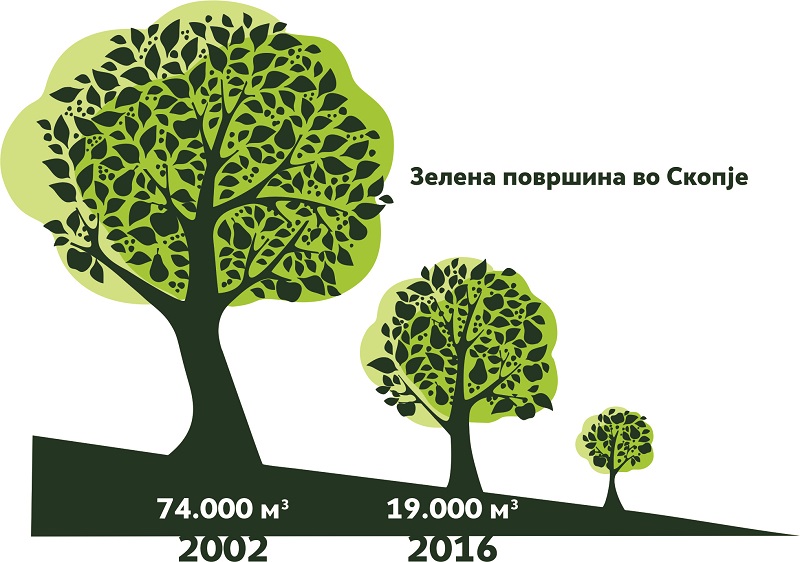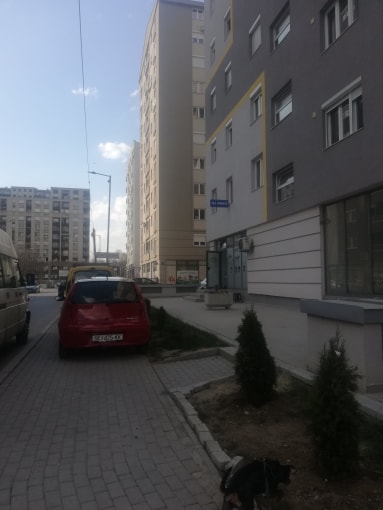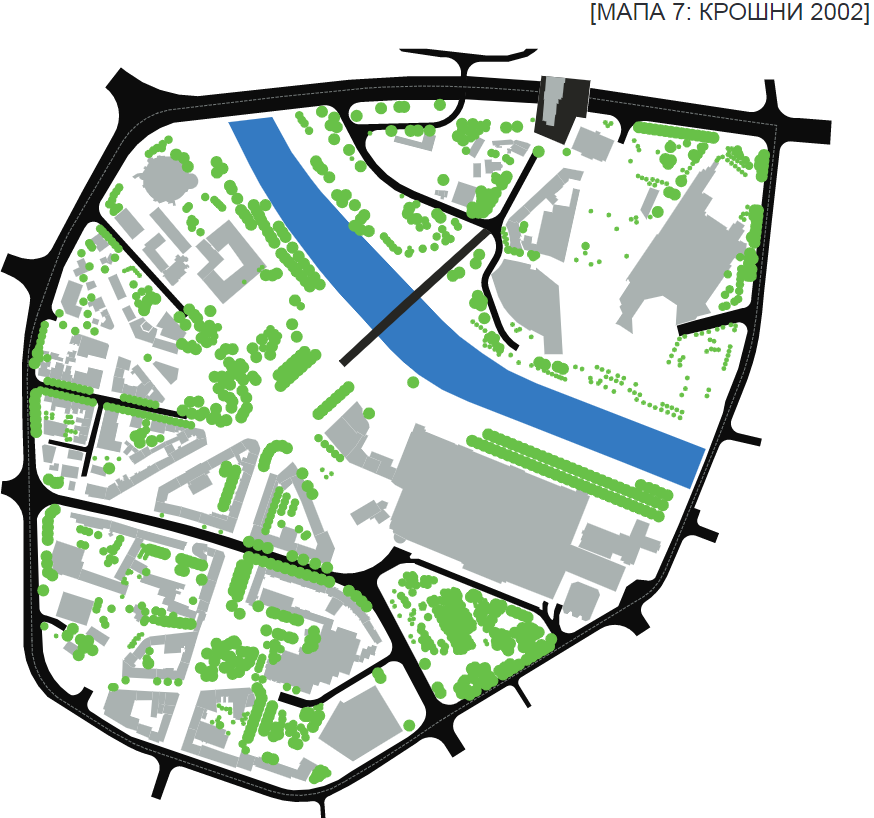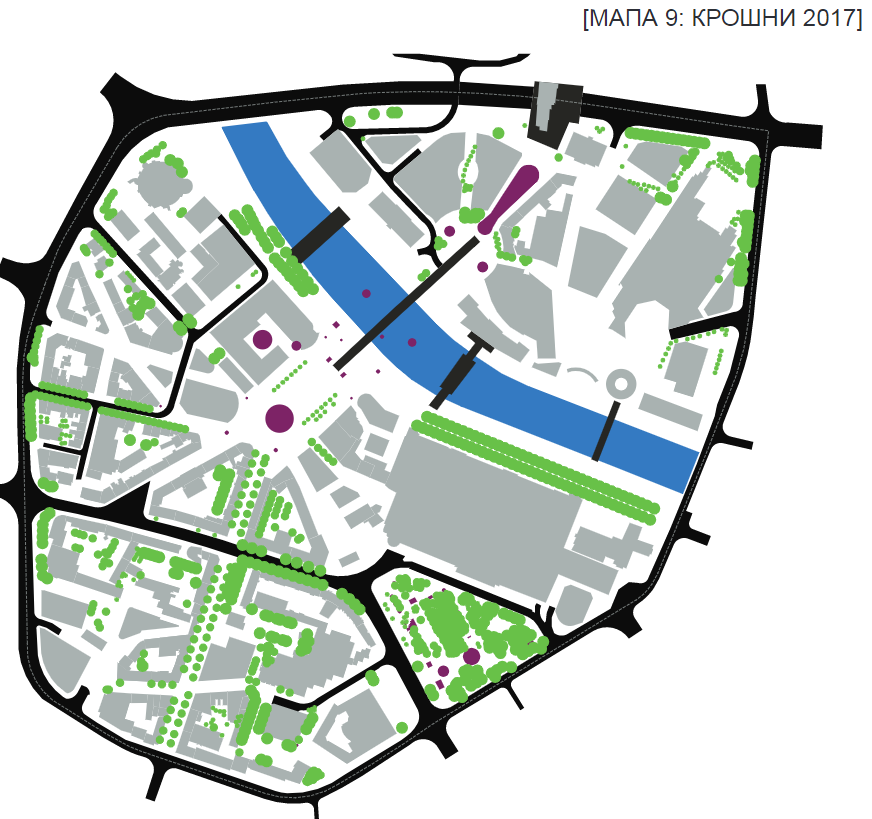Skopje faced with eco-genocide
The huge concrete monster that is being built at the junction with the Skopjanka apartment complex, on the site of the children’s playground and the local park, is the last attack on the barely remaining green area in this part of Aerodrom, which was once considered a green settlement. Among the new hundred buildings built in this region there is hardly a square meter of green space with a protective fence, so small it could easily be declared as an endangered zone. Recently, Mayor Petre Silegov also announced that there was only one remaining space untouched by the Skopje 2014 project in the city center on which, instead of a residential building, the city could plant trees and vegetation. In addition to this vacant space, from now on trees and vegetation will have to be planted on roofs, terraces and pots because the city space is completely usurped by concrete and marble. Therefore, the announcement by Mayor Silegov that he will make Skopje greener by planting vegetation on the terrace of the City Trade Center faced approval, but also disagreement, because it was a bold attempt to offer an obvious solution to something that is a realistic problem in Skopje in the last few years.
Nezavisen Vesnik/Independent daily newspaper investigated the state of the current green areas in Skopje, what was it like ten years ago, and what is being done to repair the damage from the ten-year urban insanity.

The Green Cadastre registered 100,000 trees and bushes
In order to assess the damage caused by tree cutting and the destruction of vegeatation, the City of Skopje and UNDP have been working on the the city’s first Green Cadastre for three years now. In the recent period, they have completed the shooting of 650 hectares of green areas and 100,000 trees and bushes on the boulevards and in the city parks, and it remains to be done in the municipalities and in private yards as well. The type of each tree has been noted, whether it is evergreen or deciduous, its size, age, current state, whether it is endangered or not, etc. Although North Macedonia cannot seem to manage to count its own population, the city is on a good way to count the bushes, after which it will offer a solution to reach the European average in the coming years, ie the city has 25 square meters of green areas per capita?! Considering the fact that the number of citizens is not known and the completion of the green areas is not under the competence of the municipalities, the total area of the greenery cannot be said to be the total number of seedlings on the whole territory of the city, nor, it can be accurately stated which municipality in the city of Skopje is greenest, or rather, the least green.
The Green Cadastre as an idea has been promoted long ago, and as an obligation is regulated by the Law on Urban Greenery. Students, forest engineers, biologists walked through the city with a software tool, and their target was trees in certain locations, including the Vodno park, the City park, the Park of the Francophonie and the Woman Fighter park, as well as some line boulevard trees. The Cadastre is still under construction, and funds should be provided to keep it constantly updated by the City of Skopje and PE Parks and Greenery, and in order to be able to act properly and see the benefits from it.
“Trees are usually cut because they are old and can pose a threat to the safety of citizens. I am not saying that the Skopje 2014 project did not cut many trees, although there is no specific data about this, but now a lot of trees are being planted in the parks, along the boulevards and in the block areas,” said Kristina Buzarovska, forest engineer and enumerator in the project for preparing the Green Cadastre.
“Each tree with multiple attributes, height, development of canopy, type, etc. has been registered. It can provide data on how much oxygen it produces, how much carbon dioxide it purifies, which will be taken into consideration by municipalities that have a certain area that they need to manage,” said Vladimir Stojanovski, MA in Forest Policy.
No inventory, therefore no knowledge of trees per capita

“Everyone knows that greenery is very important in urban areas, but nevertheless it is constantly hit by construction, because urban planners and investors want to simplify it, and lack the developed mind of an environmentalist. They see the building project, they want to build it, pay for it and leave,” said Ana Petrovska from the Ministry of Environment.
“It’s sad that people who, like us, breathe the same air and take care whether it’s polluted or not, on the other hand they do not have the understanding of preserving our green treasure. The new Law on Urban Greenery envisions 25 square meters of green area per capita, and the latest estimates were that there is only 12.5 square meters. When the Green Cadastre is completed, we will have more information,” said Petrovska.
According to non-governmental organizations and civil society advocates for a healthy environment, the Green Cadastre is a great move, but it’s late. They say that most countries already have a Green Cadastre, and we are only just preparing it.
“With it, we will find out what is the state of green areas in the city and it will enable improvement of the care for these green areas. The problem is that due to poor urbanization, bad policies and increased concern for profits of individuals instead of the interests of the citizens, the city lost so many green areas that I think that the Cadastre will not be able to restore it, but will only determine the scale of defeat of all of us, which we believe that healthy life can only exist in places in which there is a healthy environment,” says Jane Dimeski from the eco-friendly organization Greenbox.
Greenery as the victim
Biologist Kiril Arsovski-Przo thinks that it is senseless to carry out measures to reduce pollution, if at the same time they damage, degrade or reduce green surfaces instead of increasing them. In the settlements where there are parks or park-forests, air pollution is two to three times lower than other parts of the city, he suggests. Green plants serve as air filters that qualitatively clean the air from gases and aerosol particles, regulate outside temperature, humidity, reduce climate change, and has one other function – the more green areas than paved surfaces, the less problems with atmospheric sewage and its inflow to Vardar.
According to the official data of the Public Enterprise Parks and Greenery, Skopje has 4,131,352 square meters of green area, that is, 12.7 squares per capita if it is calculated according to the last national census of 2002, without Vodno and the green areas outside Skopje. It is too little for an urban environment that is constantly evolving, being built, being reshaped and changing and is far from the European average and the recommendations for 25 square meters per capita. According to the estimates of the non-governmental organization Reactor in Debar Maalo and Bunjakovec, that percentage will fall to 4.4% by 2020, taking into account the current state and projects according to the DUP. By comparison, in 1990, the percentage of green areas in the same settlements was over 21 per cent, and 13.8 per cent in 2012, in contrast to some European cities with up to 40 per cent of green areas!
What is worse, according to other estimates in the so-called “Mal Ring”, i.e. in the central city area, in 2013 there were about 50 per cent fewer trees than ten years ago, which can be called eco-genocide in the Municipality of Centar. Another problem is also that old and developed trees were cut down, trees that were adapted to the city climate, while they planted Japanese cherry trees, palm trees and all kinds of expensive exotic trees that provide less shade than a beach umbrella.
“Skopje has 170 kinds of trees, which is a great biodiversity, but maybe it is not so good if their characteristics are known, whether they are invasive etc. We made a proposal for planting trees by location in the future, but also be careful of it because, for instance, ash and plane trees are planted in boulevards because they produce the most oxygen and purify the most carbon dioxide, but on the other hand they have no room to develop”, said expert Vladimir Stojanovski.
Mal Ring lost 185 trees in four years
If the situation with the tree fund is monitored in the period 2002-2013, it is evident that the massive cutting of trees in the city and trees in the parks along the river Vardar, as well as on the Macedonia Square in front of the ARM, beside the building of the main post office. In the same period new trees were planted only on the streets Orce Nikolov, Maxim Gorky and along the street Macedonia. In April 2013, 33 trees were cut – almost one forest – at the headquarters of VMRO-DPMNE. The comparison of the tree fund in that period, from 2013 to 2017, shows that in just four years the central part of the city lost as many as 185 trees! Overall, in the area of Mal Ring in 2013 there were 1,646 trees, in 2017 that figure was reduced to 1,461 wood. In doing so, one should keep in mind that as years go by, there is less trees to cut.

Although there are huge differences in the degree of greenery of European cities, Skopje is still at the bottom. The most polluted are Western European cities with over 40% of greenery, followed by Eastern Europe with 15%, and the Balkans with less than 10% of the greenery. It is considered that a green area of 25 square meters per capita provides healthy and humane living, which is why it was the projection for Skopje in the General Urban Plan of 2002, which the city has never been close to achieving. From today’s perspective, it is a question of whether the estimation for 12.17 square meters of greenery per capita in the city is correct since it is based on the 2002 census, and was made in 2011. However, the city government hopes in 2020 to increase the greenery to 18.5 square meters, which is still far from the desired and planned 25 square meters per inhabitant, according to the new Law on Urban Greenery. This provision of the law should be reflected in all future general urban plans, along with the legal obligation of each parcel to have compulsory greenery from 10 to 30 per cent, depending on the purpose and location. It is further away from the real situation, considering the analysis of the greenery in Debar Maalo. Mayor Petre Silegov recently estimated that Skopje now has 40 percent less green area per capita, and not compared to the greenest European cities, but to the European average!

A new park behind the Luna Park
The second part of the City Park, on the move from the Luna Park to the Alexander Palace Hotel, will be completely floored and with vegetative arrangement. This part of the City Park has not been arranged for 70 years.
Soon the vegetative arrangement of the space behind the Macedonian Philharmonic will also start, which will cost seven million denars. Sixty new trees will be planted, and 8,000 square meters of green area will be arranged. The Municipality of Karpos also announced a new “adrenaline park” which will be started this month along the river Vardar, from the artificial rock to the wells of the Lepenec River.
These parks are part of 43 areas in the city that are planned to be arranged.
Civic associations defeated by business interests
The last case when the citizens rose in defense of green areas was when the construction of the pipeline started in Vodno. Representatives of the civic initiative “I Love Vodno” considered that people’s health was more important than profit, but although they were lying in front of the excavators, the tree cutting in Vodno continued, because this was the cheapest route for the pipeline.
Earlier, in 2013, the so-called “Park defenders” failed to save 18 trees on the stretch at the Bristol hotel, which were cut at 3 o’clock in the morning with the assistance of police and special police units. The cottonwood trees were cut in Kapistec, the trees on the Kliment Ohridski Boulevard, the black locusts at Ilinden Street, the trees around the monster-building Nastel, in Aerodrom near “Majcin dom” and many others that disturbed the citizens.
In Cair, also in 2013, 17 construction marks were issued for the construction of buildings in the place of existing parks. Citizens’ initiative from Cair collected 600 signatures and filed a request for a moratorium on all construction activities in the Municipality, after which then Mayor Izet Mexhiti announced that he was canceling 12 of the 17 marks. The municipality lost 5 million euros, but saved 12 parks.
In Karpos, civic organization Plostad Sloboda tried to stop the paving of a park, but failed because two days after the protest, the park was still covered in concrete.
Part of the trees in the center of Skopje, in front of the ARM House where the church St. Constantine and Helen was built, was also cut. Despite the protests to change the DUP, the church was still built, and there is almost no greenery left. The list of such eco-genocides continues to grow.
Biljana Bogdanovska